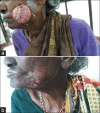Effect of Hypofractionated, Palliative Radiotherapy on Quality of Life in Late-Stage Oral Cavity Cancer: A Prospective Clinical Trial
- PMID: 31413453
- PMCID: PMC6659542
- DOI: 10.4103/IJPC.IJPC_115_18
Effect of Hypofractionated, Palliative Radiotherapy on Quality of Life in Late-Stage Oral Cavity Cancer: A Prospective Clinical Trial
Abstract
Context: The study was designed to evaluate the effect of a hypofractionated, palliative conformal radiotherapy regimen of 5250 cGy in 15 fractions in inoperable/incurable oral cavity carcinoma.
Aims: The primary objective was to assess the change in the quality of life (QOL) with respect to pain and mouth opening pre- and post-radiotherapy using standardized questionnaires. The secondary objective was to assess overall QOL using the same questionnaires and also to assess response rates, survival, compliance, early and late toxicity.
Settings and design: This was a single-arm, prospective trial. Patients with incurable oral cavity cancer referred for palliative intent radiotherapy to the Department of Radiotherapy, RCC, JIPMER were recruited into the study.
Subjects and methods: Forty-eight patients were recruited and twenty-five patients were given conformal radiotherapy to a dose of 52.5 Gy in 15 fractions. QOL was assessed using the European Organization of Research and Treatment of Cancer (EORTC) questionnaires before and 2 months after the completion of radiotherapy. The response assessment was made using the Response Evaluation Criteria in Solid Tumors (RECIST) criteria 2 months after radiotherapy. The early and late toxicities were assessed at 2 months and 6 months after radiotherapy completion, respectively.
Statistical analysis used: Sample size was calculated to be 53. The Wilcoxon signed-rank test was used to compare QOL scores pre- and post-radiotherapy. Median survival was assessed using the Kaplan-Meier method.
Results: There was a significant improvement in the pain, mouth opening, speech, social contact, social eating, felt ill items of the EORTC QLQ-H and N35 questionnaire and role functioning, emotional functioning, social functioning, fatigue, pain, insomnia, appetite loss, financial difficulties, and Global QOL subscales of the QLQ-C30 questionnaire. 72% of the patients had grade 3 acute radiation oral mucositis and 36% had grade 3 acute radiation dermatitis. There were no significant treatment breaks due to toxicity. There were no grade 3 late toxicities observed. Overall median survival was 5.1 months. The overall response rate was 47%. The median time to treatment completion was 24 days.
Conclusions: The improvement in QOL parameters suggests that the regimen of 52.5 Gy in 15 fractions is suitable for palliative intent radiotherapy in late-stage oral cavity cancer for effective palliation for short periods.
Keywords: Conformal radiotherapy; hypofractionated radiotherapy; incurable oral cavity cancer; palliative radiotherapy.
Conflict of interest statement
There are no conflicts of interest.
Figures
References
-
- Fact Sheets by Population. [Last accessed on 2017 Jul 25]. Available from: http://globocan.iarc.fr/Pages/fact_sheets_population.aspx .
-
- Vikram B. Cancers of the head and neck region in developing countries. Radiother Oncol. 2003;67:1–2. - PubMed
-
- Mohanti BK, Umapathy H, Bahadur S, Thakar A, Pathy S. Short course palliative radiotherapy of 20 Gy in 5 fractions for advanced and incurable head and neck cancer: AIIMS study. Radiother Oncol. 2004;71:275–80. - PubMed
-
- Al-mamgani A, Tans L, Van rooij PH, Noever I, Baatenburg de jong RJ, Levendag PC. Hypofractionated radiotherapy denoted as the “Christie scheme”: An effective means of palliating patients with head and neck cancers not suitable for curative treatment. Acta Oncol. 2009;48:562–70. - PubMed
LinkOut - more resources
Full Text Sources


